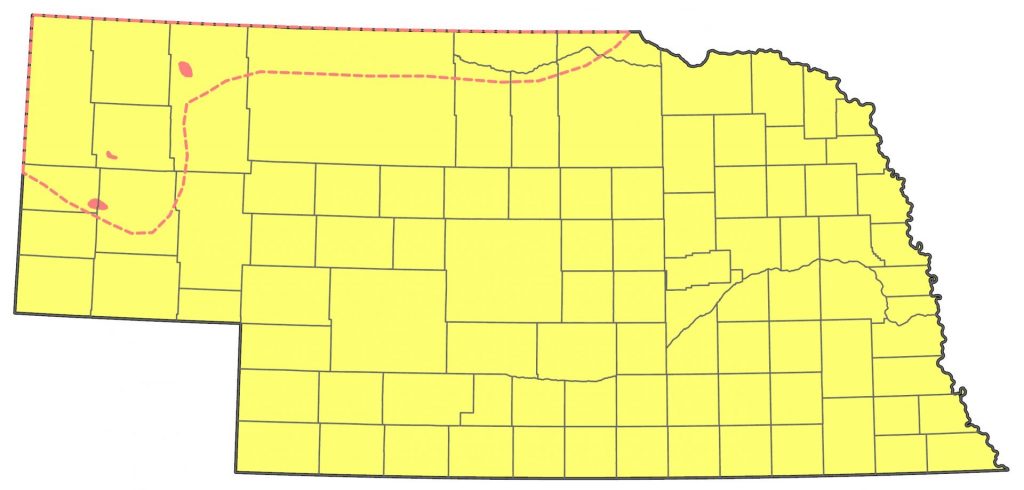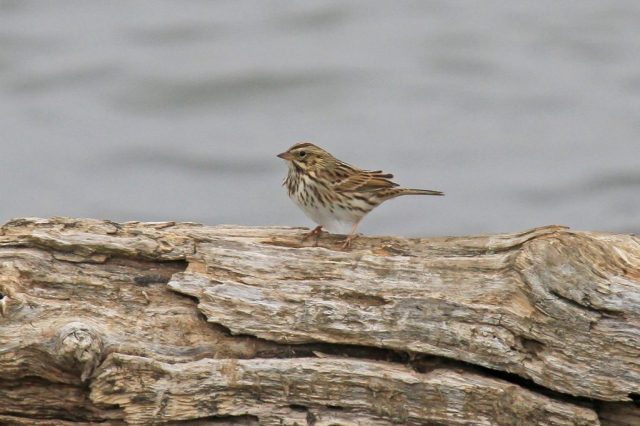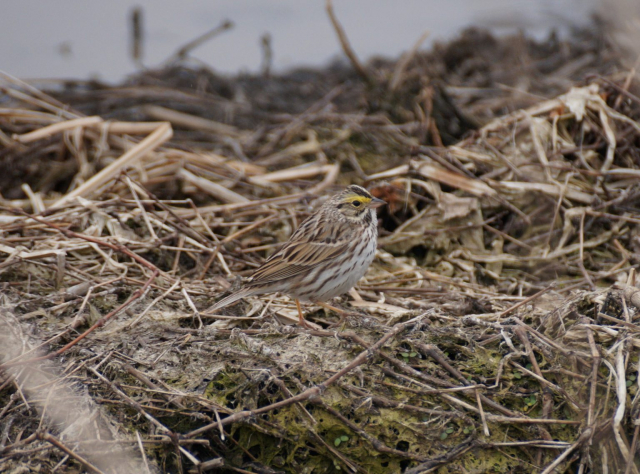Passerculus sandwichensis nevadensis, P. s. savanna, P. s. LABRADORIUS.
Status: Common, locally abundant, regular spring and fall migrant statewide. Locally uncommon regular breeder north and west. Rare casual winter visitor south and east.
Documentation: Specimens: nevadensis, UNSM ZM7285, 10 Oct 1885 Lincoln, Lancaster Co; savanna, UNSM ZM7279, 19 Oct 1901; oblitus, UNSM ZM10432, 9 Apr 1909, Lancaster Co.
Taxonomy: Seventeen subspecies are recognized (AviList 2025). Wheelwright and Rising (2020) proposed separation of the subspecies into five groups, only one of which contained non-coastal subspecies north of Mexico, the “Savannah Group”, with anthinus, breeding from northern Alaska and northwest Canada to British Columbia and northwest Manitoba, wintering southwest California to south Texas, nevadensis, breeding from British Columbia to Manitoba and south to eastern California east to the Great Basin and northern Great Plains, wintering south to California and northwest Mexico, labradorius (including oblitus), breeding eastern Manitoba to Minnesota and the northern Great Lakes region east to Labrador, wintering south to Oklahoma and Texas east to Georgia, and savanna, breeding in the southern Great Lakes region east to the Maritime Provinces and south to Iowa and New Jersey, wintering south to Florida.
According to AOU (1957), subspecies nevadensis breeds in western Nebraska, and apparently migrates through at least western and central Nebraska. Swenk (Notes Before 1925) stated that most migrants in the Inland, Clay Co and Kearney, Buffalo Co areas were nevadensis, but a 14 Apr 1914 specimen was of an “eastern” subspecies, probably savanna. Bruner et al (1904) described savanna as “a rather abundant migrant especially eastwardly”; this subspecies breeds commonly in northern and eastern Iowa (Kent and Dinsmore 1996) and has been recorded rarely in winter in Kansas (AOU 1957; Johnston 1965). There is a specimen assigned to oblitus (currently included in labradorius) taken in Lancaster Co 9 Apr 1909 (UNSM ZM10432); it seems likely that labradorius, breeding from Minnesota eastward, might occur occasionally in Nebraska as a migrant, as it winters south and west as far as southeast Texas (Pyle 1997).
Rapp et al (1958) listed the Alaskan and western Canadian subspecies anthinus for Nebraska, presumably occurring as a migrant in the west. This subspecies breeds from Alaska to British Columbia, and so a few may migrate southward east of the Rocky Mountains as do other species breeding in the Pacific Northwest (e.g., Cassin’s Vireo, Townsend’s Warbler).
To summarize, breeders in Nebraska, which occur only in the northwest, are nevadensis, and this subspecies, along with savanna and labradorius, are the expected migrants through the state. A possible additional migrant, as yet undocumented, is anthinus in the west.
Spring: Mar 12, 12, 13 <<<>>> May 28, 29, 30
Earlier dates in Mar, as well as those for Dec-Feb, are discussed under Winter. There are nine reports 3-9 Mar in the south and east that are as likely wintering birds as early migrants (see Winter); there is an uptick of reports beginning in mid-Mar (eBird.org, accessed Dec 2023).
Later dates from areas where breeding seems unlikely are 2 Jun 2024 Douglas Co, and 6 Jun 2016 Pawnee Co.
The earliest dates with tangible evidence are of singles photographed in Kearney Co 3 Mar 2018 and 9 Mar 2008 and there is a specimen date 22 Mar 1902 Lancaster Co (UNSM ZM7291).
Late May and early Jun dates are indicative of potential summering birds, especially in the northwest.
Migration is from late Mar through early May.
- High counts: 250 in Fillmore Co 28 Apr 2002, 160 in Pierce Co 8 May 1999, and 72 in Butler Co 6 May 2017.
Tout (1947) watched a flock of “thousands” 11 May 1938 in Lincoln Co. “Hundreds per mile of fence line” were seen in Nuckolls Co 20 Apr 2007.
Summer: The breeding range of this species barely reaches the northern and western edges of Nebraska (Johnsgard 1979); summering habitat consists of damp swales in grasslands (Rosche 1982). There is only one documented breeding record, but there are several other summer reports, mostly in the Panhandle, indicative of isolated breeding colonies.
The first and only confirmed breeding record was of an adult flushed from a nest with four eggs along Spotted Tail Creek in southern Sioux Co 15 Jul 1994 (Malone and McKinney; Silcock and Rosche 1994, Mollhoff 2022); birds were present there for a few years but were absent in 2010 (Wayne Mollhoff, personal communication). This general area and nearby Scotts Bluff Co seems favorable for the species; a specimen, UNSM ZM7288, was collected at Mitchell as long ago as 7 Jul 1916 and there is a breeding record there (AOU 1957). One was in Scotts Bluff Co 31 Jul 2010, and a singing bird was a few miles south of Mitchell 25 Jun 2014 in an area where suitable habitat exists. There were two records from Scotts Bluff Co in 2019: one singing in a grassy area at Scotts Bluff NM 12 Jun and another in more typical habitat along Highway 26 near Minatare 4 Jun.
Rosche (1994) considered a colony at Kilpatrick Lake, Box Butte Co to be the “largest colony known in Nebraska”; singing birds were known from this location as early as 1990 (Grzybowski 1990) but reports there since are lacking. Two were recorded 11 Jul 2022 at playas along Dakota Road at Highway 87, Box Butte Co. A new location in Sioux Co was along Buckley Road, Sioux Co 13 Jun 2021 (Raynor, eBird.org; photo), and one was in the area of Murphy Road and Highway 29, Sioux Co 25 Jun 2023.
A persistent location is the Hay Springs Creek area south and west of Hay Springs, Sheridan Co. Singing birds were found regularly three miles north of Walgren Lake and also about two miles west of Hay Springs from 1973 into the late 1990s, the latter location close to where Mollhoff found three pairs 11 Jun 2011; a breeding colony of six birds had established there by 12 Jul 2011 and 14 were present including four newly fledged young 20 Jul (Mollhoff 2022). This site has been occupied since (Mollhoff 2022); four territorial birds were there 11 Jun 2013, one or two pairs on 12 Jun 2015, and 1-2 territorial birds on 21 May 2018.
Breeding may have occurred at several additional locations, as follows.
Three were singing in wet meadows at Fleisbach WMA, Morrill Co in 1987 (Williams 1987), one was in suitable breeding habitat there 10 Jun 2007, and one was photographed singing 2 Jun 2016.
East of Lakeside, southern Sheridan Co, birds were present four years out of 10 including 26 Jun 1981 (Richard C. Rosche, personal communication). Breeding was “confirmed” at Valentine NWR, Cherry Co 29 Jun 2006 although no details were provided. Additional reports from northeastern Cherry Co are 5 Jun 2024 near Crookston, 6 Jun 2022 Valentine NWR, 2 Jul 2022 Fort Niobrara NWR, and 8 Jul 1999 Fort Niobrara NWR.
Eight singing in sedge habitat alongside streams exposed by falling water levels at Lake McConaughy, Keith Co 2 May 2004 were probably migrants, although singles were reported in the area 9 Aug (Rosche 1994), 28 Jul 2001, and 5 Jun 2005; two were in the Clear Creek Marshes area of southeastern Garden Co 28 Jul 2020. Probably a late migrant was one in Arthur Co 30 May 2019. Reports for Crescent Lake NWR, Garden Co are 28 Jul 2020, between Maverick and Goose Lakes 5 Aug 2021, in Garden Co 10 Aug 1994, and at Crescent Lake WMA 10 Aug 2022.
Three were singing in southern Holt Co 25 May 1991 and another was in Holt Co 26 Jun 2003. One was in Knox Co 14 Aug 2019, a singing male was in Dixon Co 26 May 2005, and one was in Dakota Co 6 Aug 2018. In 1982, Brogie and Mossman (1983) found no evidence of breeding in the Niobrara Valley Preserve.
There are a few undocumented late spring and summer reports from the east where breeding seems unlikely; Thompson et al (2011) stated that spring stragglers are found into Jun, some of which may be yearling females, which arrive somewhat later on the breeding grounds (Wheelwright and Rising 2020).
A Breeding Bird Atlas block in Dawson Co showing confirmed breeding (Mollhoff 2016) is a printing error (Wayne Mollhoff, personal communication).
Fall: Aug 23, 23, 24 <<<>>> Nov 6, 7, 7
Earlier dates unlikely to be of breeders are 2 Aug 2006 Seward Co, 5 Aug 2016 Johnson Co, 19 Aug 1977 Crescent Lake NWR, Garden Co, and 19 Aug 2017 Clay Co.
Jul and early Aug dates are indicative of breeding if in suitable habitat (see Summer).
Later dates are 10 Nov 2015 Clay Co, 10 Nov 2015 Washington Co, 14 Nov 2015 Sarpy Co, 14 Nov 2019 Lancaster Co, 24 Nov 2015 Fillmore Co, and 27 Nov 2020 (5) Father Hupp WMA, Thayer Co.
Migration occurs from late Aug through early Nov.
Evidence that migration begins in early Aug was provided by the presence of one at a McPherson Co site 9 Aug 2011 where none were found earlier, and the apparent departure by 10 Aug 2011 of 12 of 14 birds seen earlier at a summering site near Hay Springs. The latest specimen date is 2 Nov 1907 Lancaster Co (UNSM ZM10444).
- High counts: 500 in Hamilton Co 5 Oct 1996, 370 at Crescent Lake NWR 26 Sep 1996, 245 in Phelps and Kearney Cos 14 Oct 1995, and 200+ in Douglas Co 6 Oct 2003.
Winter: There are two documented instances of overwintering in Nebraska. Up to six were at Branched Oak Lake, Lancaster Co 2011-2012, and there were four reports of what was probably a single individual at Boyer Chute NWR, Washington Co 26 Dec-20 Feb 2012-2013.
Sightings in late Dec-early Mar are rare and probably indicative of wintering birds; such records have increased since 2010. During winter 2012-2013 there were several mid-winter reports: two were in Jefferson Co 22 Jan, one was photographed at Rowe Sanctuary, Buffalo Co 5 Feb, one was in western Seward Co 13 Feb, and one was in Dodge Co 26 Feb. One was in Omaha, Douglas Co 13-14 Feb 2014. Winter 2015-16 added three more Feb records: one was at Branched Oak Lake 4 Feb, two were at Boyer Chute NWR, and one was in Otoe Co 22 Feb. Singles were in Sarpy Co 19 Feb 2017, Nuckolls Co 25 Dec 2017, and at Marsh Wren Community Wetlands, Lancaster Co 1 Mar 2022. In winter 2022-2023 there were two reports: singles were at Little Salt Fork Marsh, Lancaster Co 7 Jan and near Valley, Douglas Co 5 Feb.
The only other documented winter reports are of singles in Keith Co 2 Jan 1999 (Jorgensen 2001), Washington Co 10 Jan 2005, Otoe Co 22 Jan 2004 (Brogie 2005), and Custer Co 26 Jan 2008.
There are reports from CBCs: 16 Dec 2011 two at Branched Oak Lake-Seward, Lancaster Co; 17 Dec 1989 Lincoln, Lancaster Co; 17 Dec 2011 seven at Omaha, Douglas Co; 18 Dec 1998 Harlan County Reservoir, Harlan Co; 22 Dec 1977 six at DeSoto NWR, Washington Co; and 29 Dec 1964 two at Scottsbluff, Scotts Bluff Co.
Savannah Sparrow winters on occasion in southern Kansas (Thompson et al 2011) and northern Missouri; Robbins (2018) noted that there has been a “dramatic” increase in wintering numbers in central and southern Missouri.
Images
Abbreviations
CBC: Christmas Bird Count
NM: National Monument
NWR: National Wildlife Refuge
UNSM: University of Nebraska State Museum
WMA: Wildlife Management Area (State)
Literature Cited
American Ornithologists’ Union [AOU]. 1957. The AOU Check-list of North American birds, 5th ed. Port City Press, Baltimore, Maryland, USA.
AviList Core Team, 2025. AviList: The Global Avian Checklist, v2025. https://doi.org/10.2173/avilist.v2025.
Brogie, M.A. 2005. 2004 (16th) Report of the NOU Records Committee. NBR 73: 78-84.
Brogie, M.A., and M.J. Mossman. 1983. Spring and summer birds of the Niobrara Valley Preserve, Nebraska: An annotated checklist. NBR 51: 44-51.
Bruner, L., R.H. Wolcott, and M.H. Swenk. 1904. A preliminary review of the birds of Nebraska, with synopses. Klopp and Bartlett, Omaha, Nebraska, USA.
Grzybowski, J.A. 1990. Southern Great Plains Region. American Birds 44: 1152-1154.
Johnsgard, P.A. 1979. Birds of the Great Plains: breeding species and their distribution. University of Nebraska Press, Lincoln, Nebraska, USA.
Johnston, R.F. 1965. A directory to the birds of Kansas. Miscellaneous Publication No. 41. University of Kansas Museum of Natural History, Lawrence, Kansas, USA.
Jorgensen, J.G. 2001. 1999 (Eleventh) Report of the NOU Records Committee. NBR 69: 85-91.
Kent, T.H., and J.J. Dinsmore. 1996. Birds in Iowa. Publshed by the authors, Iowa City and Ames, Iowa, USA.
Mollhoff, W.J. 2016. The Second Nebraska Breeding Bird Atlas. Bull. Univ. Nebraska State Museum Vol 29. University of Nebraska State Museum, Lincoln, Nebraska, USA.
Mollhoff, W.J. 2022. Nest records of Nebraska birds. Nebraska Ornithologists’ Union Occasional Paper Number 9.
Pyle, P. 1997. Identification Guide to North American Birds. Part I, Columbidae to Ploceidae. Slate Creek Press, Bolinas, California, USA.
Rapp, W.F. Jr., J.L.C. Rapp, H.E. Baumgarten, and R.A. Moser. 1958. Revised checklist of Nebraska birds. Occasional Papers 5, Nebraska Ornithologists’ Union, Crete, Nebraska, USA.
Robbins, M.B. 2018. The Status and Distribution of Birds in Missouri. University of Kansas Biodiversity Institute, Lawrence, Kansas, USA.
Rosche, R.C. 1982. Birds of northwestern Nebraska and southwestern South Dakota, an annotated checklist. Cottonwood Press, Crawford, Nebraska, USA.
Rosche, R.C. 1994. Birds of the Lake McConaughy area and the North Platte River valley, Nebraska. Published by the author, Chadron, Nebraska, USA.
Silcock, W.R., and R.C. Rosche. 1994. Summer Field Report, June-July 1994, NBR 62: 102-116.
Swenk, M.H. Notes before 1925. Bird notes from A.M. Brooking of Hastings, C.A. Black of Kearney, and B.J. Olson of Kearney, based chiefly on their collections, up to January 1, 1925. Typed manuscript in the Nebraska Ornithologists’ Union Archives, University of Nebraska State Museum, Lincoln, Nebraska, USA.
Thompson, M.C., C.A. Ely, B. Gress, C. Otte, S.T. Patti, D. Seibel, and E.A. Young. 2011. Birds of Kansas. University Press of Kansas, Lawrence, Kansas, USA.
Tout, W. 1947. Lincoln County birds. Published by the author, North Platte, Nebraska, USA.
Wheelwright, N.T. and J.D. Rising. 2020. Savannah Sparrow (Passerculus sandwichensis), version 1.0. In Birds of the World (A. F. Poole, Editor). Cornell Lab of Ornithology, Ithaca, NY, USA. https://doi.org/10.2173/bow.savspa.01.
Williams, F. 1987. Southern Great Plains Region. American Birds 41: 1455-1458.
Recommended Citation
Silcock, W.R., and J.G. Jorgensen. 2025. Savannah Sparrow (Passerculus sandwichensis). In Birds of Nebraska — Online. www.BirdsofNebraska.org
Birds of Nebraska – Online
Updated 22 Jul 2025, map updated 17 Jan 2024


